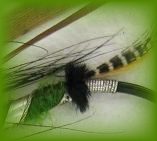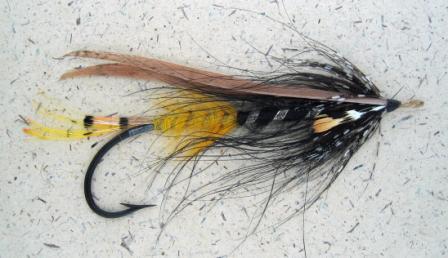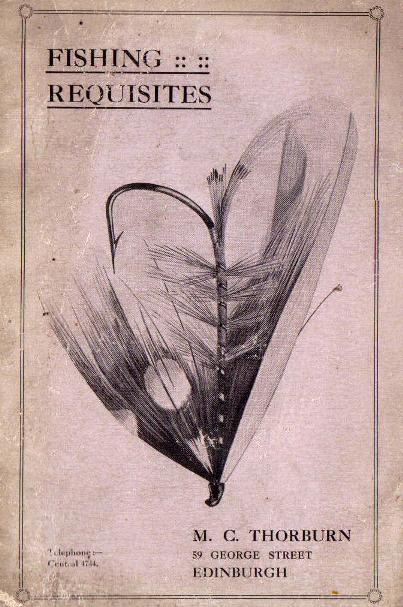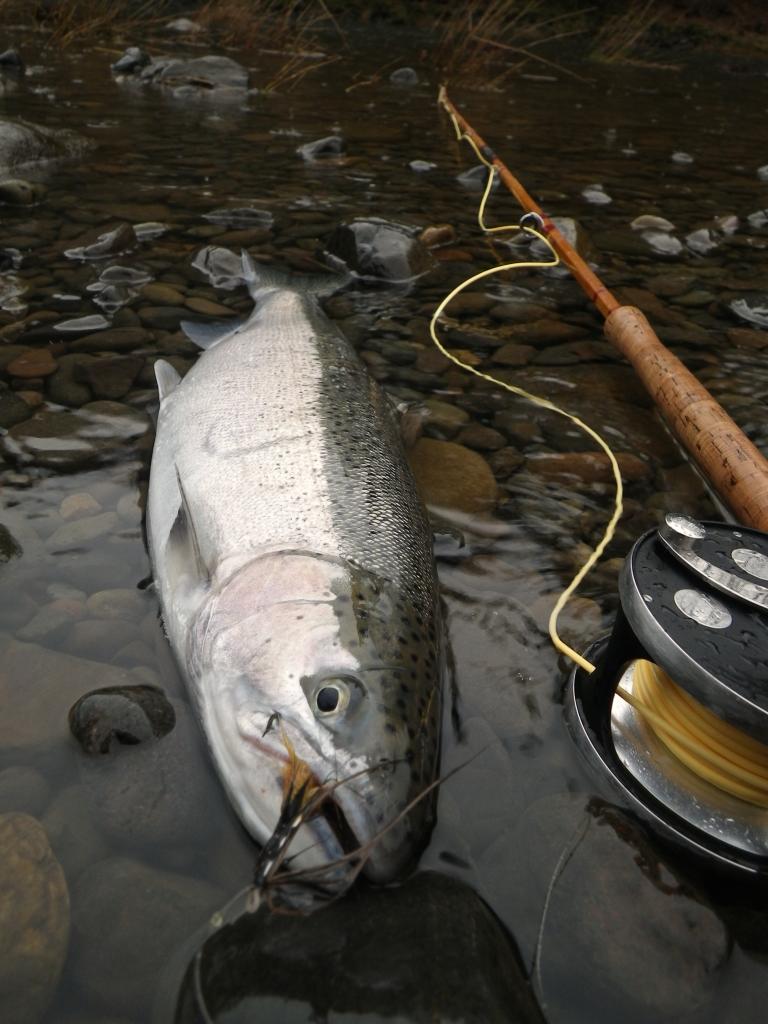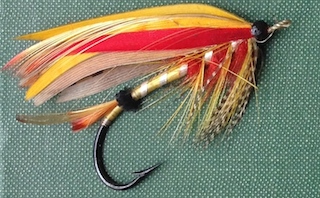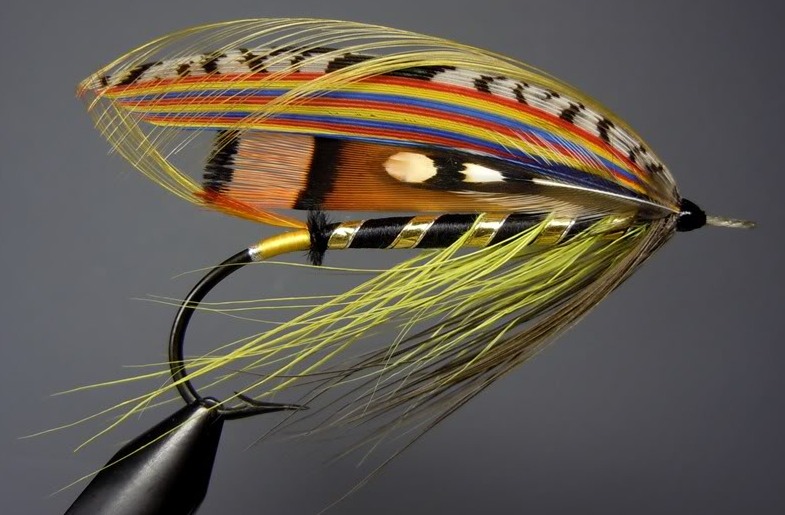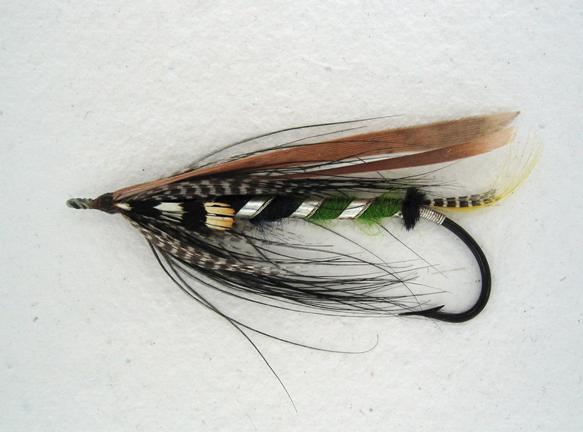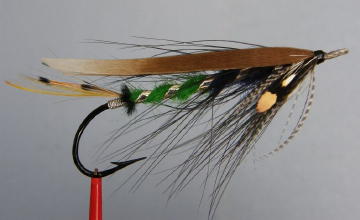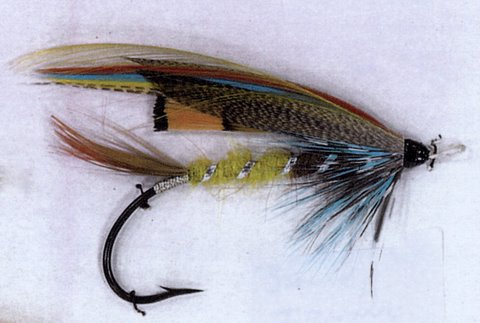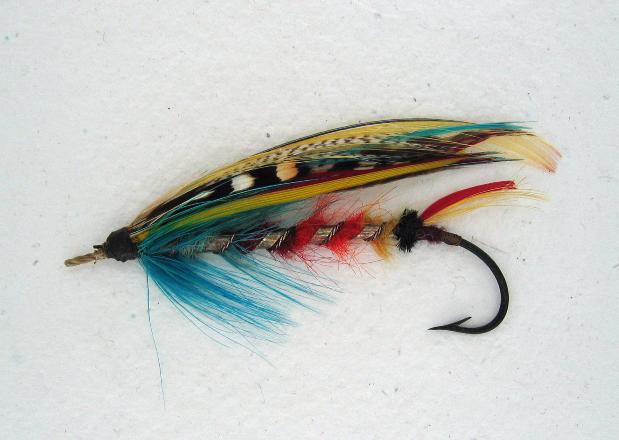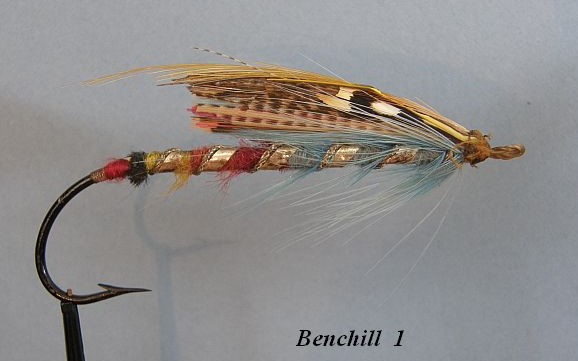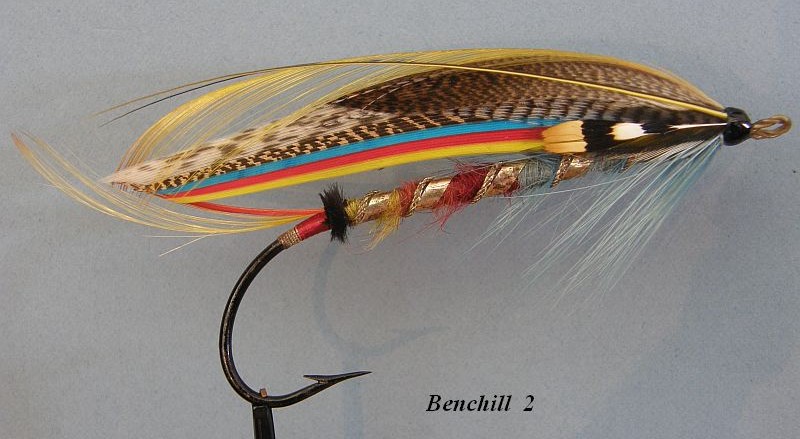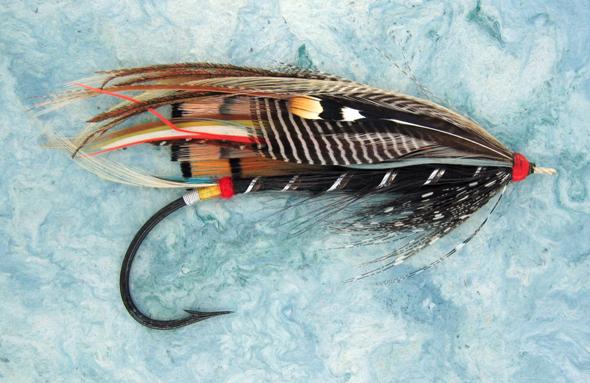 |
 |
|
On this page Aboyne Peacock, Akroyd, Badger, Ballater, Balmoral, Beaconsfield, Bell Irving, Benchill, Black Doctor - please page down. Akroyd
Vintage 9/0 Vintage tube supplied by JS Sharpe
The above is the front cover of Miss M.C. Thorburn's catalogue for 1926 - I've always liked it - it gets across the thin body well The Scotsman “A Veteran Sportsman - The Late Mr. C. H. Akroyd A well-known sportsman, and one of the last of the old school, who knew sporting conditions of the Highlands and of foreign countries, including After matriculating at Oxford Mr. Akroyd had adventurous travels, and in Constantinople he was introduced to Hobart Pasha, who gave him permission to shoot in the preserves in the neighbourhood of From “A Veteran Sportsman’s Diary” by Charles Akroyd, 1926. The following is an entry for 1875. “Major Traherne tied a beautiful fly, and it gave me great pleasure to watch him. He took the most extraordinary pains to dress them perfectly, and I am sure I have seen him taking an hour trying to get a feather to sit properly. I always used to dress my own flies, but I dressed for speed, not for appearance; never the less my rough and ready affairs caught fish every bit as well as Traherne’s fancies. I hardly ever dressed two flies alike; I just sat down and dressed away just as the spirit moved me. This was the year in which I produced the “Akroyd” fly, which I am told by those who at the present time are fishing the
WM Tag: Gold tinsel. Tail: A topping and golden pheasant tippet. Body: Yellow and black mohair in equal proportion. Hackle: Yellow hackle over yellow mohair and black heron hackle over black mohair. Cheeks: Jungle cock. Wing: White or brown turkey. Head: Black
Interesting to note that there is no ribbing on this pattern, is it a mistake?
Kelson – The Salmon Fly, 1885 Tag: Gold twist. Tail: Topping and tippet strands. Body: The first half yellow seal’s fur, having a yellow hackle along it; followed by black seal’s fur, and a black hackle along it. Ribs: Gold tinsel. Throat: Black heron. Wings: Two strips of cinnamon turkey showing light points. Sides: Jungle (short and dropping). An excellent Kelson attributes the pattern to George Blacklaws.
Pryce-Tannatt - How to Dress Salmon Flies, 1914 Tag: Silver tinsel. Tail: A topping and tippet in strands. Body: First half, light orange seals fur; second half, black floss. Ribs: Oval silver tinsel over the orange seal’s fur; flat silver tinsel and twist over black floss. Hackle: A lemon hackle over the orange seal’s fur; a black heron’s hackle over the black floss. Throat: Teal. Wings: A pair of cinnamon turkey tail strips (set flat). White turkey tail strips are often used, in which case the pattern is known as the white-winged Akroyd. Cheeks: Jungle cock (drooping). Hook: 1½ to 3 inches. Hardy – Salmon Fishing, 1907 Tag: Gold tinsel. Tail: Topping and tippet strands. Body: The first half yellow seal’s fur, with yellow hackle; followed by black seal’s fur, with black hackle. Ribs: Gold tinsel. Throat: Black heron. Wings: Two strips of cinnamon turkey with light tips. Sides: Jungle cock. Head: Black.
The Scotsman newspaper, “How to tie Salmon Flies” Tag: Silver tinsel. Tail: A topping and tippet in strands. Body: First half, light orange seal’s fur, second half black floss. Ribs: Oval silver tinsel and twist over black floss. Hackle: A lemon wound over the orange fur, a black heron or long black cock hackle over the black floss. Throat: Teal. Wings: Cinnamon turkey tail or white turkey tail or (at a pinch) white swan. Cheeks: Jungle cock lying down over hackle instead of up over wings.
Akroyds still catch fish!
Akroyd tied by and fish caught by Aaron Ostoj Pictorial Step by Step Akroyd dressing - by me so appologies - but it may help the novice tie their first Dee Fly
Below the finished fly, ready to fish on the Dee next Spring......
Akroyd also came up with the Gloriosa Superba - this is an excellent vintage example probably from Farlow
Badger
Badger tied by Guy Heard for fishing WM Tag: Silver tinsel Tail: Golden pheasant saddle feather Body: Claret mohair Ribbing: Silver twist and gold twist Hackle: White cock hackle with black centre three fourths down body Wings: Mottled (distinct black and white) turkey. Head: Black The “Badger” is a fly we consider would do pretty well in subsiding water of almost any colour incident on the WM Tag: Silver thread. Tail: A small topping and fibres of tippet. Body: Turkey red mohair. Ribbed: Silver tinsel, four turns. Wings: Light, mottled turkey strips – the lighter the better. Hackle: White with black roots. Head: Red. Limericks, 7, 8, and 9, double irons.
Kelson – The Salmon Fly, 1885 Tag: Silver twist. Tail: A topping and tippet strands. Body: Crimson seal’s fur. Ribs: Silver tinsel (oval). Throat: A natural silver furnace hackle. Wings: Two strips of light, mottled turkey. This summer pattern, used on the Kelson attributes the pattern to William Garden. Hardy – Salmon Fishing, 1907 Tag: Silver tinsel. Tail: A topping and tippet strands. Body: Crimson seal’s fur. Ribs: Silver tinsel. Throat: Silver furnace hackle. Wings: Two strips of light, mottled turkey. Head: Black
The Ballater A beautiful contemporary tying by Kjell-Ove Karlsen - using dyed heron for the body hackle (much better than the flies illustrated in the P-T book!)
Tag: Silver tinsel and golden yellow floss. Tail: A topping and Indian Crow. Butt: Black herl. Body: Black floss. Ribs: Flat gold with silver oval tinsel and gold tinsel. (what this means is flat gold with the silver oval bordering it on the barb side and gold oval bordering the flat on the eye side - hope that's understandable!) Hackle: A lemon hackle. Throat: Grey heron. Wings: A pair of tippets (back to back) veiled with married strands of blue, yellow and red goose and Sides: Jungle cock, a topping over. Head: Black varnish.
Balmoral
Vintage - note pintail in the tail from Murdochs 1886 dressing WM Green body, silver tinsel, black hackle, jungle cock, red wings, and golden pheasant tag WM Tag: Silver tinsel and orange floss. Tail: A topping and fibres of golden pheasant tippet. Body: Three turns green, and two turns black mohair. Ribbed: Silver tinsel and gold twist. Hackle: Black heron well down body. Cheeks: Jungle cock feather on either cheek. Wing: Dark brown Head: Black. William Murdoch, Tag: Silver twist. Tail: A topping andpintail. Butt: Black ostrich. Body: Bright green and black mohair - two thirds of the former to one third of the latter. Ribbed: Silver tinsel (flat) and silver cord. Hackle: Black heron of the longest fibre - from bright green mohair. Shoulder: Teal - sparingly. Wings: Strips of cream coloured turkey feather extending flatwise outward from the top of the iron at an angle of 15 degrees. Cheeks: Jungle. Head: Varnished. The pattern of the excellent spring fly above described is dressed by Mr. Wm. Garden, fishing-tackle maker,
Kelson – The Salmon Fly, 1885 Tag: Silver twist. Tail: A topping and tippet strands. Butt: Black herl. Body: Green and dark blue seal’s fur, equally divided. Ribs: Silver lace and silver tinsel. Hackle: Black heron from green fur. Throat: Widgeon. Wings: Two strips of plain cinnamon turkey. Sides: Jungle (short and dropping) A favourite Hardy – Salmon Fishing, 1907 Tag: Silver tinsel. Tail: A topping and tippet strands. Butt: Black herl. Body: Green and dark blue seal’s fur, equally divided. Ribs: Silver lace and silver tinsel. Hackle: Black heron from green fur. Throat: Widgeon. Wings: Two strips of plain cinnamon turkey. Sides: Jungle cock. Head: Black.
Kelson - Land & Water Cards “Beaconsfield,” thanks to the enquiries made by Colonel French of Portsmouth, was invented by George Bradlaws [Blacklaws], a fisherman in the employ of Admiral Sir Arthur Farquhar, and is dressed from the following particulars:-
Tag: Silver twist and yellow silk. Tail: A topping with teal and ibis. Butt: Black herl, rebutted with half a dozen close coils of the silver twist. Body: In three equal sections doubly butted as before, each being decorated with a patch of the same colour mohair, as illustrated; the first, yellow; the second, dark red-orange; the third claret. Throat: Light blue hackle. Wings: Double tippets, veiled with olden pheasant tail, silver and brown speckled turkey, bustard, teal and mallard, having thin married strips of light yellow, very light red-claret and light blue placed in the centre and a golden pheasant topping above. Horns: Blue macaw. Head: Black herl.
Kelson – The Salmon Fly, 1885 Tag: Silver twist and yellow silk. Tail: A topping, teal and ibis. Butt: Black herl, followed by two turns silver tinsel. Body: In three equal sections; the first two, doubly butted; thus No. 1 of yellow silk with a yellow mane (mohair), black herl, and two turns of silver tinsel. No. 2, red-orange silk; a red-orange mane (mohair), back herl and two turns of silver tinsel. No. 3, claret silk. Throat: Light blue hackle. Wings: Two tippets (back to back) veiled with golden pheasant tail, light and dark mottled turkey, bustard, teal, swan dyed yellow, red and light blue; mallard and a topping. Horns: Blue macaw. Head: Black herl. A very useful, showy fly, well known on the Test; but it seems to have been forgotten on the Kelson attributes the pattern to George Blacklaws. Hardy – Salmon Fishing, 1907 Tag: Silver tinsel and yellow silk. Tail: A topping, teal and ibis. Butt: Black herl, followed by two turns silver tinsel. Body: In three equal sections; the first two, doubly butted; thus No. 1 of yellow silk with a yellow mane (mohair), black herl, silver tinsel. No. 2, red-orange floss; a red-orange mane (mohair), back herl and silver tinsel. No. 3, claret floss. Throat: Light blue hackle. Wings: Two tippets veiled with golden pheasant tail, light and dark mottled turkey, bustard, teal, swan dyed yellow, red and blue; mallard and a topping. Horns: Blue macaw. Head: Black.
Bell Irvine (or Bell Irving)
Tied by Colin Simpson (with a great torpedo head)
Pattern from Colin & Alex Simpson, this fly is in both William Garden's and Charles Playfair's catalogues from the early 1900's under both spellings!
Tag: Oval silver. Tail: Golden pheasant breast. Body: ½ yellow mohair, ½ fiery brown mohair. Rib: Flat silver. Throat: Light blue and guinea fowl. Wing: Tippet strands, golden pheasant tail, light bustard, grey mallard, blue yellow and claret swan, bronze mallard and a topping.
Benchill
Vintage
A very "mothed" vintage one
The same fly after hospital treatment by Dr Bob I have spent years pronouncing the name of this fly incorrectly as "Bench Hill" - the correct pronunciation is "Benkle" (thanks Donald) and is named after the pool Benchill on the Fishponds beat of the lower Tay. Malloch, the manufacturer of angling materials, has earned a high reputation as a fly-dresser, which is one branch of the business he carries on at As far as my own observations are concerned, I have noticed that the majority of Benchill’s successes were in rough and rapid waters, to which I quite believe the fly is best suited. The Benchill is dressed in the following way: Tag: Silver twist and red-claret silk. Tail: A topping and scarlet ibis. Butt: Black herl. Body: Very dark yellow, very light orange, red-claret and light blue seal’s fur. Ribs: Silver tinsel. Hackle: Light blue, over the light blue seal’s fur. Wings: Double tippets, veiled with light speckled turkey, swan dyed yellow and red; bustard, golden pheasant tail, teal and mallard, and a golden topping. Horns: Blue macaw.
Kelson – The Salmon Fly, 1885 Tag: Silver tinsel and red-claret silk. Tail: A topping and scarlet ibis. Butt: Black herl. Body: Dark yellow, light orange, red-claret, and light blue seal’s fur in equal portions. Ribs: Silver tinsel. Hackle: Light blue, from red-claret fur. Wings: Two tippets (back to back) extending only to end of dark yellow fur, veiled with light mottled turkey, swan dyed yellow and red, bustard, golden pheasant tail, teal, mallard and a topping. Horns: Blue macaw. This is a special favourite of mine; and I consider it as the best pattern in the Earn. I have also used it with much success on the Tweed, Spey, Lochy and Blackwater, Co. Kelson attributes the pattern to Peter Malloch. Kelson also mentions that the Benchill can be tied with a silk body in his book Tips from 1901: “It was the “Silk Bodied Benchill,” a first-class pattern.” Hardy – Salmon Fishing, 1907 Tag: Silver tinsel and red claret floss. Tail: A topping and ibis. Butt: Black herl. Body: Dark yellow, light orange, red-claret, and light blue seal’s fur in equal parts. Ribs: Silver tinsel. Hackle: Light blue, from red-claret fur. Wings: Two tippets, veiled with light mottled turkey, swan dyed yellow and red, bustard, golden pheasant tail, teal, mallard and a topping. Horns: Blue macaw. Head: Black.
Black Doctor
Vintage Wallbran - The British Angler Tag: Silver tinsel and golden floss. Tail: A topping and chatterer. Body: Black floss. Ribbed: Broad silver tinsel. Hackle: Black, with teal at shoulder. Wing: Under wings, slips swan dyed various shades of green; over wings, bustard, slips of swan dyed green, red, blue, yellow and light green, peacock’s wing, strips of dark mallard, topping over all. Horns: blue macaw. Head: A turn of red crewel. Mr. Murdoch writes: - “I have all my Silver and Black Doctors dressed exactly to these patterns. I consider they are more effective when thus dressed than if dressed in the ordinary way; in my own experience they have proved so at any rate.”
Though some may experience differently, I can say without hesitation that on dull days late in October no fly used when the river is low is half so deadly as the Black Doctor. I put this fly far in front of all others, especially on hazy, calm days. Small sizes should be used, unless the casts are very deep and shaded, or of good strength of current and rough in character. I tone down the wing of this fly with material that gives it when wet a nice dark appearance, a greenish shade being distinctly observable. Little Guinea Fowl at the shoulder is what everyone should see to, as a lot of it neutralises the effect greatly. This is a discovery I made, and I may frankly state that until I found it out I had many and many a time but “so-so” sport on good waters late in the season when there was no sky or sunshine, and the river was low and clear. Of the Black Doctor, I never use when fishing in October a larger than 0 or smaller than No. 4 size. I use the 1, 1½, and the 0 sizes in cold rough weather when the trees are shedding their leaves.
Pryce-Tannatt - How to Dress Salmon Flies, 1914 Tag: Silver thread and lemon floss Tail: A topping and Indian crow. Butt: Scarlet Berlin wool. Body: Black Floss Ribs: Oval silver tinsel Hackle: A dark claret hackle. Throat: Speckled gallina. Wings: Mixed - tippet in strands with strips of golden pheasant over; “married” strands of scarlet, blue and yellow swan, florican, bustard, peacock wing, and light, mottled turkey tail; “married” narrow strips of teal and barred summer duck; narrow strips of brown mallard over; a topping over all. Head: Scarlet wool Hook: 1¼ to 2 inches. Hardy – Salmon Fishing, 1907 Tag: Silver tinsel and yellow floss. Tail: A topping and chatterer. Butt: Scarlet Berlin wool. Body: Black floss. Ribs: Silver tinsel. Hackle: Black. Throat: Jay. Wing: Tippets in strands; pintail; dark mottled turkey; blue and yellow swan; red macaw; guinea fowl; golden pheasant tail; mallard; topping. Sides: Jungle cock. Cheeks: Chatterer. Horns: Blue macaw. Head: Red.
|
